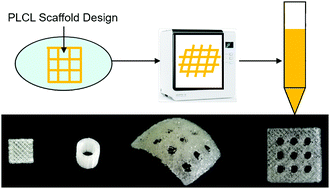3D printing of implantable elastic PLCL copolymer scaffolds†
Abstract
Poly(L-lactic acid) (PLLA) scaffolds have been used in regenerative medicine, however, they commonly suffer from low flexibility, restricting their application in the repair and reconstruction of soft tissues. In this study, poly(L-lactide-co-ε-caprolactone) (PLCL) copolymers were examined to modulate the elasticity of PLLA with the random presence of CL units in PLLA. Thermodynamic analysis revealed that the introduction of PCL could significantly decrease the melting point and glass transition temperature of PLLA, benefiting the extrusion and printing of PLCL. Diverse scaffolds with designed architectures including porous cubes with or without large holes, cambered plates with holes and round tubes could be easily constructed by 3D printing. In the process of elastic deformation, the maximum elastic stress of the copolymer scaffold was obviously increased from 19.6 to 31.5 MPa when the relative content of PCL was increased to 70%, while the elongation at break was evidently increased from 388% to about 1974%. The Young's modulus of PLCL was also significantly decreased (P < 0.05) in comparison with that of PLLA. PLCL scaffolds have good platelet and endotheliocyte adhesion ability and no obvious hemolysis was observed. In vivo subcutaneous implantation of PLCL scaffolds demonstrated superior biocompatibility. Collectively, this work highlights that copolymerization of PCL segments into PLLA is an effective approach to tune the 3D printability and the stiffness and elasticity of PLLA scaffolds. PLCL scaffolds hold great promise for the regeneration of soft tissues including but not limited to cartilage, myocardium, muscle, tendon and nervous tissues.



 Please wait while we load your content...
Please wait while we load your content...